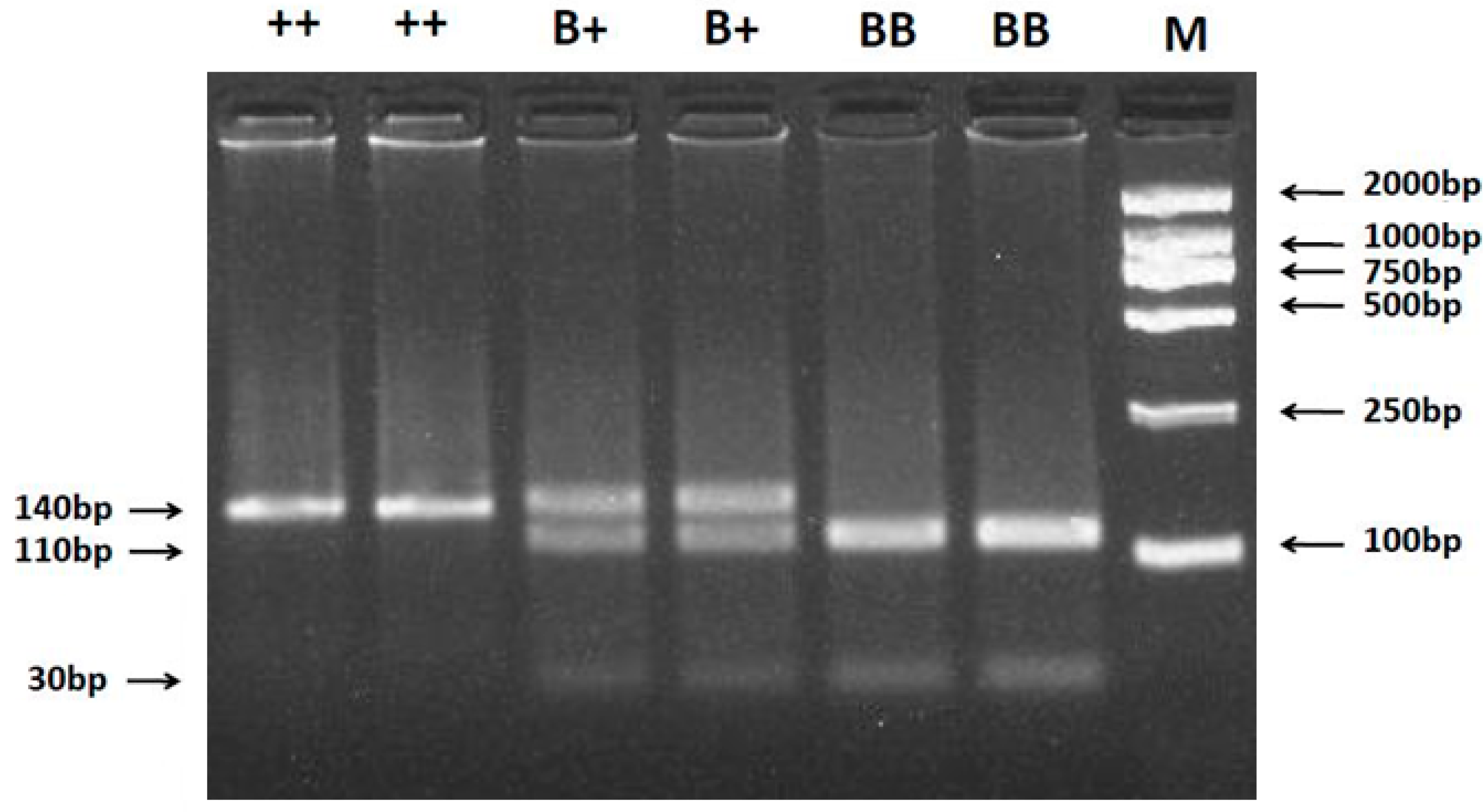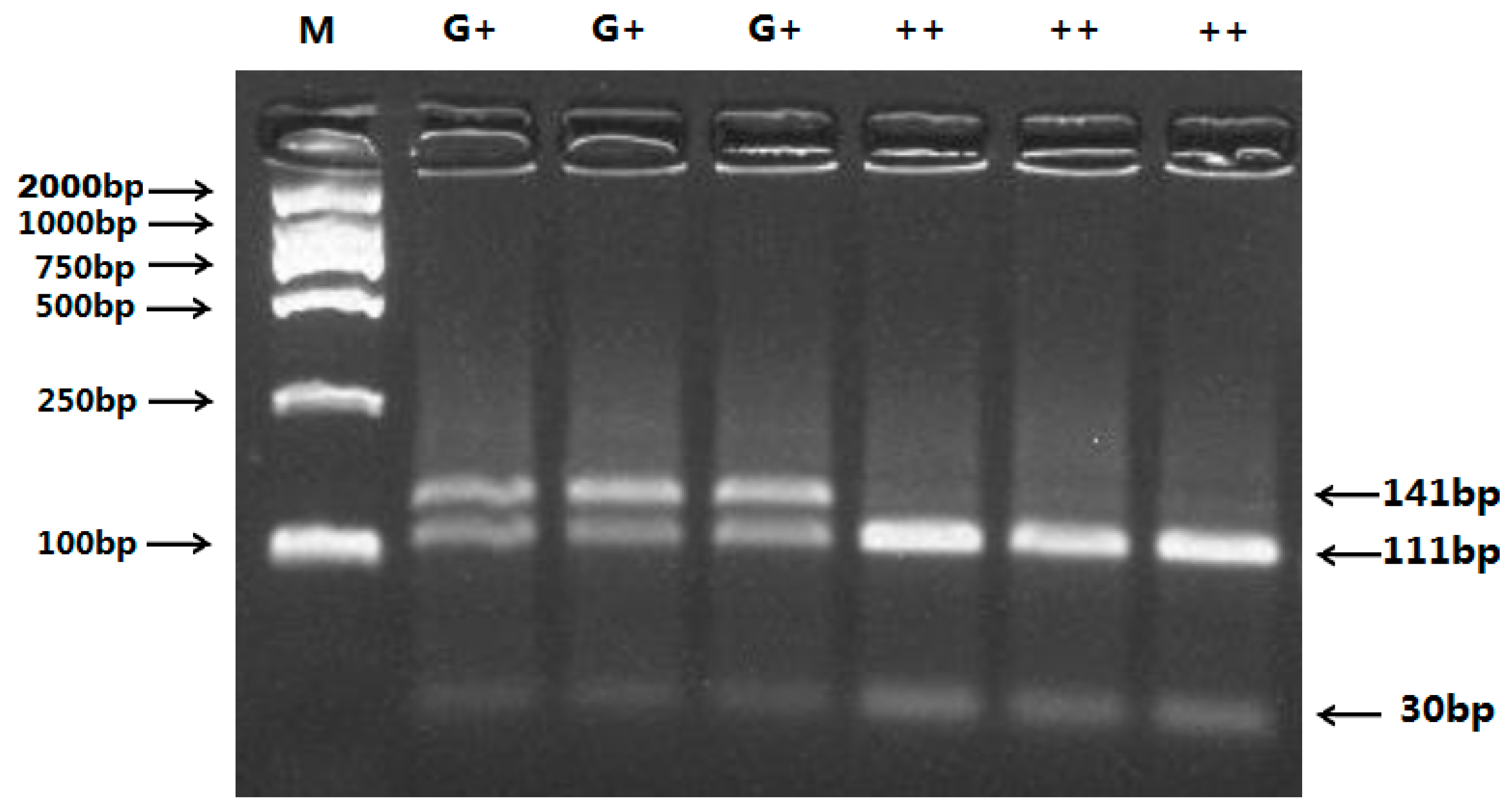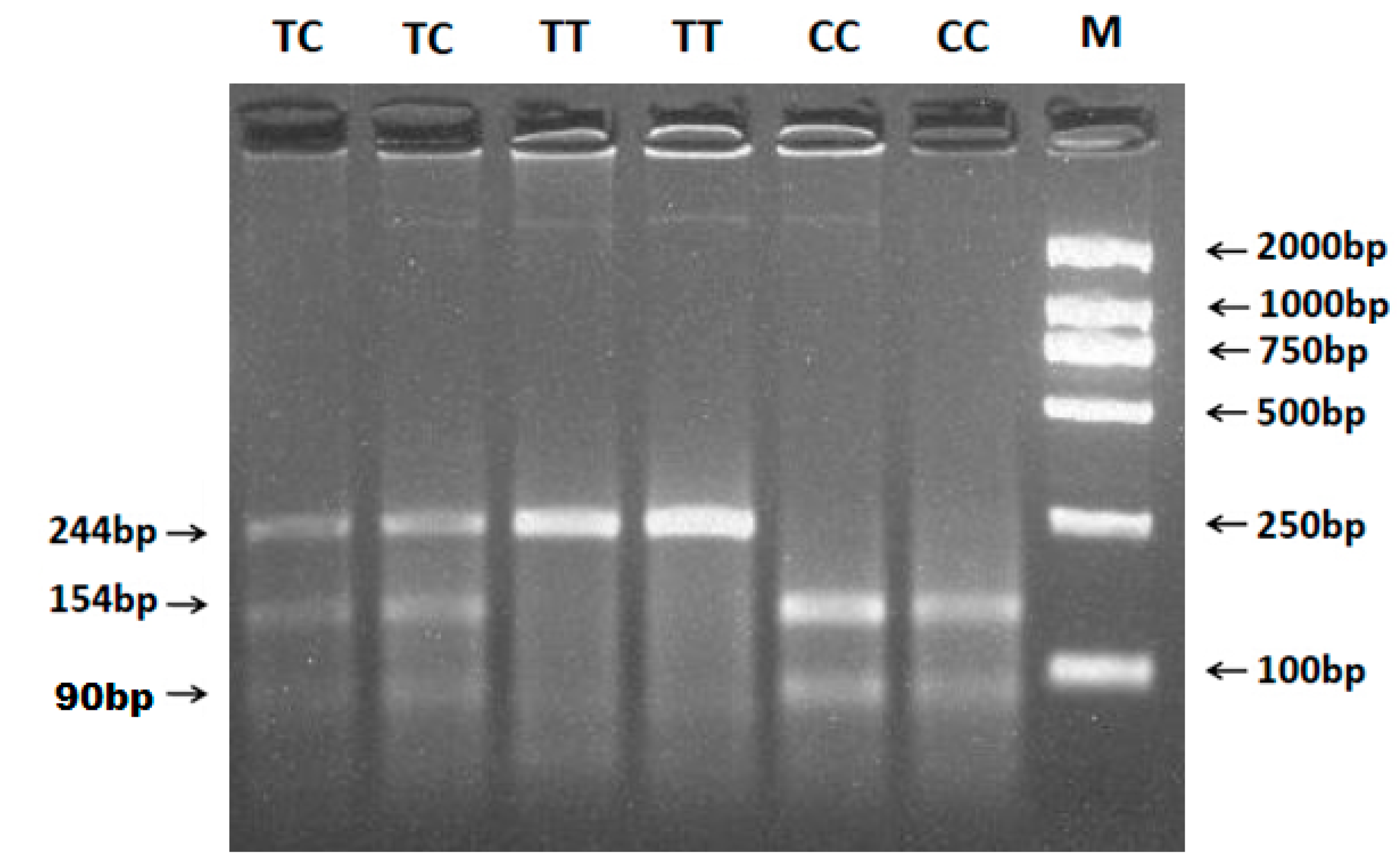Polymorphisms of the Ovine BMPR-IB, BMP-15 and FSHR and Their Associations with Litter Size in Two Chinese Indigenous Sheep Breeds
Abstract
:1. Introduction
2. Results
2.1. Genotyping and Allele Frequency Analysis



2.2. Single Marker-Trait Association
| Gene | Total Population | Small Tail Han Sheep | Hu Sheep | ||||||||||||
|---|---|---|---|---|---|---|---|---|---|---|---|---|---|---|---|
| Genotype Frequency | Allele Frequency | Genotype Frequency | Allele Frequency | Genotype Frequency | Allele Frequency | ||||||||||
| BMPR-IB | BB | B+ | ++ | B | + | BB | B+ | ++ | B | + | BB | B+ | ++ | B | + |
| 0.09 | 0.89 | 0.02 | 0.53 | 0.47 | 0.10 | 0.88 | 0.02 | 0.54 | 0.46 | 0.08 | 0.90 | 0.02 | 0.53 | 0.47 | |
| BMP-15 | GG | G+ | ++ | G | + | GG | G+ | ++ | G | + | GG | G+ | ++ | G | + |
| 0 | 0.29 | 0.71 | 0.15 | 0.85 | 0 | 0.4 | 0.6 | 0.20 | 0.80 | 0 | 0.17 | 0.83 | 0.08 | 0.92 | |
| FSHR | CC | TC | TT | C | T | CC | TC | TT | C | T | CC | TC | TT | C | T |
| 0.02 | 0.61 | 0.37 | 0.33 | 0.67 | 0.02 | 0.42 | 0.56 | 0.24 | 0.76 | 0.02 | 0.83 | 0.15 | 0.44 | 0.56 | |
| Gene | Genotype 1 | Total Population | Small Tail Han Sheep | Hu Sheep | |||
|---|---|---|---|---|---|---|---|
| No. of Ewes | Litter Size | No. of Ewes | Litter Size | No. of Ewes | Litter Size | ||
| BMPR-IB | BB | 142 | 1.95 ± 0.070 A | 85 | 2.06 ± 0.078 A | 57 | 1.89 ± 0.092 A |
| B+ | 1450 | 1.75 ± 0.020 B | 765 | 1.78 ± 0.026 B | 685 | 1.74 ± 0.026 B | |
| ++ | 38 | 1.17 ± 0.115 C | 19 | 1.21 ± 0.166 C | 19 | 1.15 ± 0.150 C | |
| BMP-15 | G+ | 479 | 1.96 ± 0.035 a | 351 | 1.91 ± 0.039 | 128 | 2.18 ± 0.063 a |
| ++ | 1151 | 1.66 ± 0.019 b | 518 | 1.71 ± 0.032 | 633 | 1.66 ± 0.028 b | |
| FSHR | CC | 39 | 2.31 ± 0.124 Aa | 21 | 2.33 ± 0.157 Aa | 18 | 2.29 ± 0.158 A |
| TC | 1000 | 1.79 ± 0.023 Bb | 368 | 1.88 ± 0.038 Ab | 632 | 1.75 ± 0.028 B | |
| TT | 591 | 1.56 ± 0.050 Bc | 480 | 1.70 ± 0.033 Bc | 111 | 1.49 ± 0.068 B | |
| Gene | Genotype | Total Population | Small Tail Han Sheep | Hu Sheep | |||
|---|---|---|---|---|---|---|---|
| No. of Ewes | Litter Size | No. of Ewes | Litter Size | No. of Ewes | Litter Size | ||
| BMPR-IB/BMP-15 | ++/++ | 29 | 1.17 ± 0.071 Dd | 13 | 1.15 ± 0.104 Bc | 16 | 1.19 ± 0.101 Bbc |
| ++/G+ | 9 | 1.22 ± 0.147 Dcd | 6 | 1.33 ± 0.211 Bbc | 3 | 1.00 ± 0.000 Bc | |
| B+/++ | 1029 | 1.66 ± 0.020 BCbc | 450 | 1.71 ± 0.033 ABbc | 579 | 1.63 ± 0.025 ABabc | |
| BB/++ | 93 | 1.82 ± 0.073 ABb | 55 | 1.84 ± 0.089 ABab | 38 | 1.79 ± 0.126 ABab | |
| B+/G+ | 412 | 1.93 ± 0.036 ABab | 315 | 1.87 ± 0.041 ABab | 106 | 2.13 ± 0.068 Aa | |
| BB/G+ | 49 | 2.35 ± 0.129 Aa | 30 | 2.47 ± 0.157 Aa | 19 | 2.16 ± 0.220 Aa | |
| BMPR-IB/FSHR | ++/TC | 23 | 1.17 ± 0.081 Dd | 8 | 1.13 ± 0.125 Bd | 15 | 1.20 ± 0.107 |
| ++/TT | 15 | 1.20 ± 0.107 Dcd | 11 | 1.27 ± 0.141 Bcd | 4 | 1.00 ± 0.000 | |
| B+/TT | 518 | 1.67 ± 0.030 BCbcd | 431 | 1.69 ± 0.033 Bbcd | 87 | 1.57 ± 0.069 | |
| B+/TC | 896 | 1.76 ± 0.022 BCbcd | 315 | 1.86 ± 0.042 ABbcd | 581 | 1.70 ± 0.026 | |
| BB/TT | 58 | 1.91 ± 0.099 BCbc | 38 | 1.89 ± 0.112 ABbcd | 20 | 1.95 ± 0.198 | |
| BB/TC | 81 | 2.02 ± 0.093 BCb | 45 | 2.16 ± 0.123 ABabc | 36 | 1.86 ± 0.139 | |
| B+/CC | 36 | 2.31 ± 0.125 ABab | 19 | 2.26 ± 0.168 ABab | 17 | 2.35 ± 0.191 | |
| BB/CC | 3 | 3.000 ± 0.577 Aa | 2 | 3.00 ± 1.000 Aa | 1 | 3.00 | |
| BMP-15/FSHR | ++/TT | 425 | 1.63 ± 0.032 Cc | 340 | 1.66 ± 0.036 Bc | 85 | 1.51 ± 0.072 Cd |
| ++/TC | 707 | 1.67 ± 0.024 Cc | 169 | 1.78 ± 0.058 ABbc | 538 | 1.63 ± 0.025 BCcd | |
| G+/TT | 166 | 1.81 ± 0.055 BCc | 140 | 1.78 ± 0.60 ABbc | 26 | 2.00 ± 0.136 ABCbcd | |
| G+/TC | 293 | 2.01 ± 0.045 BCbc | 199 | 1.97 ± 0.055 ABabc | 94 | 2.10 ± 0.080 ABCabc | |
| ++/CC | 19 | 2.21 ± 0.181 ABab | 9 | 2.22 ± 0.222 ABab | 10 | 2.20 ± 0.291 ABab | |
| G+/CC | 20 | 2.50 ± 0.170 Aa | 12 | 2.42 ± 0.260 Aa | 8 | 2.63 ± 0.183 Aa | |
| Gene | Genotype | Total Population | Small Tail Sheep | Hu Sheep | |||
|---|---|---|---|---|---|---|---|
| No. of Ewes | Litter Size | No. of Ewes | Litter Size | No. of Ewes | Litter Size | ||
| BMPR-IB/BMP-15/FSHR | ++/G+/TC | 5 | 1.00 ± 0.000 Ee | 2 | 1.00 ± 0.000 | 3 | 1.00 ± 0.000 |
| ++/++/TT | 11 | 1.09 ± 0.091 DEde | 7 | 1.14 ± 0.143 | 4 | 1.00 ± 0.000 | |
| ++/++/TC | 18 | 1.22 ± 0.101 CDEcde | 6 | 1.17 ± 0.167 | 12 | 1.25 ± 0.131 | |
| ++/G+/TT | 4 | 1.50 ± 0.289 BCDEbcde | 4 | 1.50 ± 0.289 | 0 | - | |
| B+/++/TT | 378 | 1.64 ± 0.034 BCDEbcde | 307 | 1.67 ± 0.038 | 71 | 1.51 ± 0.075 | |
| B+/++/TC | 633 | 1.66 ± 0.025 BCDEbcde | 135 | 1.78 ± 0.066 | 498 | 1.63 ± 0.026 | |
| BB/++/TT | 36 | 1.75 ± 0.122 BDCEbcde | 26 | 1.77 ± 0.128 | 10 | 1.70 ± 0.300 | |
| B+/G+/TT | 140 | 1.76 ± 0.059 BCDEbcde | 124 | 1.75 ± 0.063 | 16 | 1.88 ± 0.155 | |
| BB/++/TC | 56 | 1.86 ± 0.093 BCDEbcde | 28 | 1.89 ± 0.130 | 28 | 1.82 ± 0.137 | |
| B+/G+/TC | 263 | 1.99 ± 0.045 BCDEbcd | 180 | 1.92 ± 0.055 | 83 | 2.14 ± 0.079 | |
| BB/G+/TT | 22 | 2.18 ± 0.156 BCDbc | 12 | 2.17 ± 0.207 | 10 | 2.20 ± 0.249 | |
| B+/++/CC | 18 | 2.22 ± 0.191 BCb | 8 | 2.25 ± 0.250 | 10 | 2.20 ± 0.291 | |
| B+/G+/CC | 18 | 2.39 ± 0.164 Bb | 11 | 2.27 ± 0.237 | 7 | 2.57 ± 0.202 | |
| BB/G+/TC | 25 | 2.40 ± 0.200 Bb | 17 | 2.59 ± 0.211 | 8 | 2.00 ± 0.423 | |
| BB/G+/CC | 2 | 3.50 ± 0.500 Aa | 1 | 4.00 | 1 | 3.00 | |
2.3. Combined Effect Analysis of BMPR-IB, BMP-15 and FSHR Genes on Litter Size
3. Discussion
4. Experimental Section
4.1. Ethics Statement
4.2. Experimental Population
| Breed | No. | Litter Size |
|---|---|---|
| Hu Sheep | 761 | 1.706 ± 0.024 a |
| Small Tail Han Sheep | 869 | 1.791 ± 0.025 a |
| Total | 1630 | 1.752 ± 0.017 |
4.3. DNA Extraction and Genotyping
| Gene | Primer Sequences (5'-3') | Tm (°C) | PCR Product Size (bp) | Restriction Endonuclease | Citation |
|---|---|---|---|---|---|
| BMPR-IB-F | GTCGCTATGGGGAAGTTTGGATG | 59 | 140 | Ava II | [1] |
| BMPR-IB-R | CAAGATGTTTTCATGCCTCATCAACACGGTC | ||||
| BMP-15-F | CACTGTCTTCTTGTTACTGTATTTCAATGAGAC | 63 | 141 | Hinf I | [6] |
| BMP-15-R | GATGCAATACTGCCTGCTTG | ||||
| FSHR-F | CGTATCTTTCCACGCCCTCT | 58 | 244 | BsiE I | [14] |
| FSHR-R | CCATCCACCCGATTGCTT |
4.4. Statistical Analysis
5. Conclusions
Acknowledgments
Author Contributions
Conflicts of Interest
References
- Wilson, T.; Wu, X.Y.; Juengel, J.L.; Ross, I.K.; Lumsden, J.M.; Lord, E.A.; Dodds, K.G.; Walling, G.A.; McEwan, J.C.; OʼConnell, A.R.; et al. Highly prolific Booroola sheep have a mutation in the intracellular kinase domain of bone morphogenetic protein IB receptor (ALK-6) that is expressed in both oocytes and granulosa cells. Biol. Reprod. 2001, 64, 1225–1235. [Google Scholar] [CrossRef] [PubMed]
- Mulsant, P.; Lecerf, F.; Fabre, S.; Schibler, L.; Monget, P.; Lanneluc, I.; Pisselet, C.; Riquet, J.; Monniaux, D.; Callebaut, I.; et al. Mutation in bone morphogenetic protein receptor-IB is associated with increased ovulation rate in Booroola Merino ewes. Proc. Natl. Acad. Sci. USA 2001, 98, 5104–5109. [Google Scholar] [CrossRef] [PubMed]
- Souza, C.J.; MacDougall, C.; MacDougall, C.; Campbell, B.K.; McNeilly, A.S.; Baird, D.T. The Booroola (FecB) phenotype is associated with a mutation in the bone morphogenetic receptor type 1 B (BMPR1B) gene. J. Endocrinol. 2001, 169, R1–R6. [Google Scholar] [CrossRef] [PubMed]
- Galloway, S.M.; McNatty, K.P.; Cambridge, L.M.; Laitinen, M.P.; Juengel, J.L.; Jokiranta, T.S.; McLaren, R.J.; Luiro, K.; Dodds, K.G.; Montgomery, G.W.; et al. Mutations in an oocyte-derived growth factor gene (BMP-15) cause increased ovulation rate and infertility in a dosage-sensitive manner. Nat. Genet. 2000, 25, 279–283. [Google Scholar] [CrossRef] [PubMed]
- Crawford, J.L.; Heath, D.A.; Reader, K.L.; Quirke, L.D.; Hudson, N.L.; Juengel, J.L.; McNatty, K.P. Oocytes in sheep homozygous for a mutation in bone morphogenetic protein receptor 1B express lower mRNA levels of bone morphogenetic protein 15 but not growth differentiation factor 9. Reproduction 2011, 142, 53–61. [Google Scholar] [CrossRef] [PubMed]
- Hanrahan, J.P.; Gregan, S.M.; Mulsant, P.; Mullen, M.; Davis, G.H.; Powell, R.; Galloway, S.M. Mutations in the genes for oocyte-derived growth factors GDF9 and BMP-15 are associated with both increased ovulation rate and sterility in Cambridge and Belclare sheep (Ovis aries). Biol. Reprod. 2004, 70, 900–909. [Google Scholar] [CrossRef] [PubMed]
- Sprengel, R.; Braun, T.; Nikolics, K.; Segaloff, D.L.; Seeburg, P.H. The Testicular Receptor for Follicle-Stimulating-Hormone—Structure and functional expression of cloned cDNA. Mol. Endocrinol. 1990, 4, 525–530. [Google Scholar] [CrossRef] [PubMed]
- Gharib, S.D.; Wierman, M.E.; Shupnik, M.A.; Chin, W.W. Molecular-biology of the pituitary gonadotropins. Endocr. Rev. 1990, 11, 177–199. [Google Scholar] [CrossRef] [PubMed]
- Tisdall, D.J.; Watanabe, K.; Hudson, N.L.; Smith, P.; Mcnatty, K.P. Fsh Receptor gene-expression during ovarian follicle development in sheep. J. Mol. Endocrinol. 1995, 15, 273–281. [Google Scholar] [CrossRef] [PubMed]
- Sairam, M.R.; Subbarayan, V.S.R. Characterization of the 5' flanking region and potential control elements of the ovine follitropin receptor gene. Mol. Reprod. Dev. 1997, 48, 480–487. [Google Scholar] [CrossRef] [PubMed]
- Liu, S.F.; Du, L.X.; Wang, A.H. Biological characteristics of the 5' regulatory region of FSHR gene in sheep. Yi Chuan 2006, 28, 427–431. [Google Scholar] [PubMed]
- Chu, M.X.; Guo, X.H.; Feng, C.J.; Li, Y.; Huang, D.W.; Feng, T.; Cao, G.L.; Fang, L.; di, R.; Tang, Q.Q.; et al. Polymorphism of 5' regulatory region of ovine FSHR gene and its association with litter size in Small Tail Han sheep. Mol. Biol. Rep. 2012, 39, 3721–3725. [Google Scholar] [CrossRef] [PubMed]
- Zhao, Y.Z. Zhong Guo Yang Yang Xue, 1st ed.; China Agriculture Press: Beijing, China, 2003; pp. 90–95. [Google Scholar]
- Pan, X.; Liu, S.; Li, F.; Wang, W.; Li, C.; Ma, Y.; Li, T. Molecular characterization, expression profiles of the ovine FSHR gene and its association with litter size. Mol. Biol. Rep. 2014, 41, 7749–7754. [Google Scholar] [CrossRef] [PubMed]
- Chu, M.X.; Liu, Z.H.; Jiao, C.L.; He, Y.Q.; Fang, L.; Ye, S.C.; Chen, G.H.; Wang, J.Y. Mutations in BMPR-IB and BMP-15 genes are associated with litter size in Small Tailed Han sheep(Ovis aries). J. Anim. Sci. 2007, 85, 598–603. [Google Scholar] [CrossRef] [PubMed]
- Davis, G.H.; Galloway, S.M.; Ross, I.K.; Gregan, S.M.; Ward, J.; Nimbkar, B.V.; Ghalsasi, P.M.; Nimbkar, C.; Gray, G.D.; Subandriyo; et al. DNA tests in prolific sheep from eight countries provide new evidence on origin of the Booroola (FecB) mutation. Biol. Reprod. 2002, 66, 1869–1874. [Google Scholar] [CrossRef] [PubMed]
- Davis, G.H.; Balakrishnan, L.; Ross, I.K.; Wilson, T.; Galloway, S.M.; Lumsden, B.M.; Hanrahan, J.P.; Mullen, M.; Mao, X.Z.; Wang, G.L.; et al. Investigation of the Booroola (FecB) and Inverdale (FecX(I)) mutations in 21 prolific breeds and strains of sheep sampled in 13 countries. Anim. Reprod. Sci. 2006, 92, 87–96. [Google Scholar] [CrossRef] [PubMed]
- Guan, F.; Liu, S.R.; Shi, G.Q.; Yang, L.G. Polymorphism of FecB gene in nine sheep breeds or strains and its effects on litter size, lamb growth and development. Anim. Reprod. Sci. 2007, 99, 44–52. [Google Scholar] [CrossRef] [PubMed]
- McNatty, K.P.; Moore, L.G.; Hudson, N.L.; Quirke, L.D.; Lawrence, S.B.; Reader, K.; Hanrahan, J.P.; Smith, P.; Groome, N.P.; Laitinen, M.; et al. The oocyte and its role in regulating ovulation rate: A new paradigm in reproductive biology. Reproduction 2004, 128, 379–386. [Google Scholar] [CrossRef] [PubMed]
- Shimasaki, S.; Moore, R.K.; Otsuka, F.; Erickson, G.F. The bone morphogenetic protein system in mammalian reproduction. Endocr. Rev. 2004, 25, 72–101. [Google Scholar] [CrossRef] [PubMed]
- Juengel, J.L.; McNatty, K.P. The role of proteins of the transforming growth factor-β superfamily in the intraovarian regulation of follicular development. Hum. Reprod. Update 2005, 11, 144–161. [Google Scholar] [CrossRef]
- Fabre, S.; Pierre, A.; Mulsant, P.; Bodin, L.; di Pasquale, E.; Persani, L.; Monget, P.; Monniaux, D. Regulation of ovulation rate in mammals: Contribution of sheep genetic models. Reprod. Biol. Endocr. 2006, 4. [Google Scholar] [CrossRef]
- Chu, M.X.; Sang, L.H.; Wang, J.Y.; Fang, L.; Ye, S.C. Study on BMP-15 and GDF9 as candidate genes for prolificacy of Small Tail Han sheep. Yi Chuan 2005, 32, 38–45. [Google Scholar]
- Wang, Q.G.; Zhong, F.G.; Li, H.; Wamg, X.H.; Liu, S.R.; Chen, X.J.; Gan, S.Q. Detection of major gene on litter size in sheep. Yi Chuan 2005, 27, 80–84. [Google Scholar] [PubMed]
- Banerjee, A.A.; Dupakuntla, M.; Pathak, B.R.; Mahale, S. FSH receptor specific residues L501 and I505 in extracellular loop 2 are essential for its function. J. Mol. Endocrinol. 2015, 54, 193–204. [Google Scholar] [CrossRef] [PubMed]
- Rivera, O.E.; Varayoud, J.; Rodriguez, H.A.; Santamaria, C.G.; Bosquiazzo, V.L.; Osti, M.; Belmonte, N.M.; Munoz-de-Toro, M.M.; Luque, E.H. Neonatal exposure to xenoestrogens impairs the ovarian response to gonadotropin treatment in lambs. Reproduction 2015, 149, 645–655. [Google Scholar] [CrossRef] [PubMed]
- Zhang, R.; Zhang, S.; Zhu, X.; Zhou, Y.; Wu, X. Follicle-stimulating hormone receptor (FSHR) in Chinese alligator, Alligator sinensis: Molecular characterization, tissue distribution and mRNA expression changes during the female reproductive cycle. Anim. Reprod. Sci. 2015, 156, 40–50. [Google Scholar] [CrossRef] [PubMed]
© 2015 by the authors; licensee MDPI, Basel, Switzerland. This article is an open access article distributed under the terms and conditions of the Creative Commons Attribution license (http://creativecommons.org/licenses/by/4.0/).
Share and Cite
Wang, W.; Liu, S.; Li, F.; Pan, X.; Li, C.; Zhang, X.; Ma, Y.; La, Y.; Xi, R.; Li, T. Polymorphisms of the Ovine BMPR-IB, BMP-15 and FSHR and Their Associations with Litter Size in Two Chinese Indigenous Sheep Breeds. Int. J. Mol. Sci. 2015, 16, 11385-11397. https://doi.org/10.3390/ijms160511385
Wang W, Liu S, Li F, Pan X, Li C, Zhang X, Ma Y, La Y, Xi R, Li T. Polymorphisms of the Ovine BMPR-IB, BMP-15 and FSHR and Their Associations with Litter Size in Two Chinese Indigenous Sheep Breeds. International Journal of Molecular Sciences. 2015; 16(5):11385-11397. https://doi.org/10.3390/ijms160511385
Chicago/Turabian StyleWang, Weimin, Shijia Liu, Fadi Li, Xiangyu Pan, Chong Li, Xiaoxue Zhang, Youji Ma, Yongfu La, Rui Xi, and Tingfu Li. 2015. "Polymorphisms of the Ovine BMPR-IB, BMP-15 and FSHR and Their Associations with Litter Size in Two Chinese Indigenous Sheep Breeds" International Journal of Molecular Sciences 16, no. 5: 11385-11397. https://doi.org/10.3390/ijms160511385
APA StyleWang, W., Liu, S., Li, F., Pan, X., Li, C., Zhang, X., Ma, Y., La, Y., Xi, R., & Li, T. (2015). Polymorphisms of the Ovine BMPR-IB, BMP-15 and FSHR and Their Associations with Litter Size in Two Chinese Indigenous Sheep Breeds. International Journal of Molecular Sciences, 16(5), 11385-11397. https://doi.org/10.3390/ijms160511385





